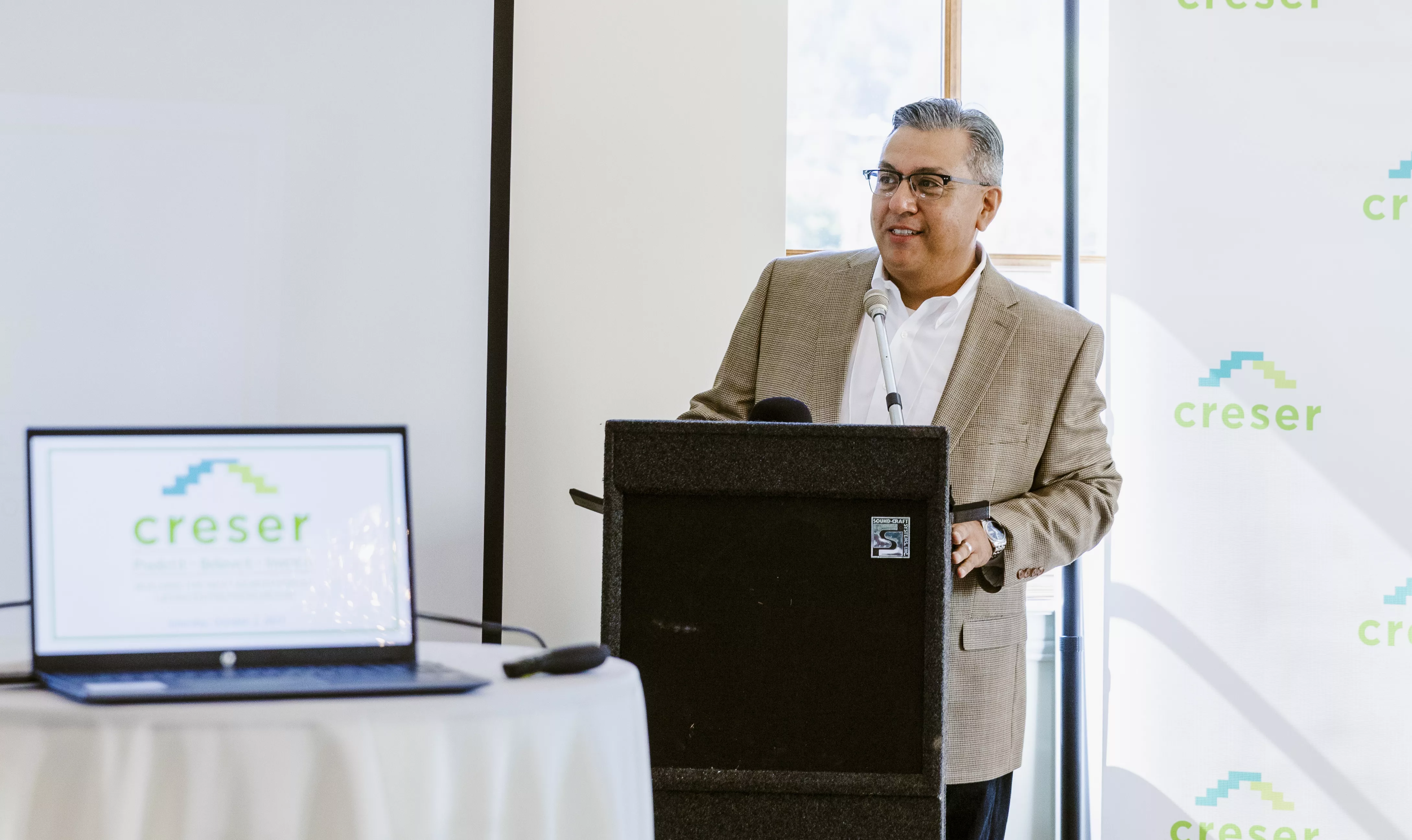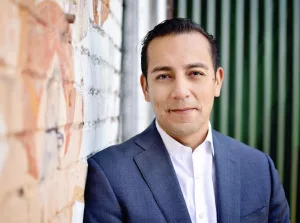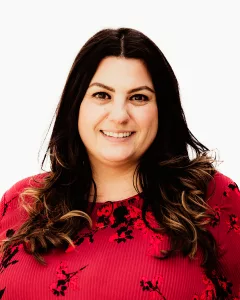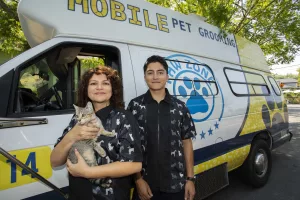
Juan Hernandez is CEO of Creser Capital Fund, which offers microloans to local Latino entrepreneurs.
When it comes to owning a business, there’s still a huge disparity for the Latino community in trying to acquire capital to open or grow their own business. According to the State of Latino Entrepreneurship 2020 research study from the Standford Latino Entrepreneurship Initiative, only 20% of Latino-owned businesses that applied for national bank loans of more than $100,000 obtained funding—by comparison, 50% of white-owned businesses received such loans.
When looking at loans of all sizes, the percentages change, but the gap doesn’t: Among Latinos, only 51% received loans versus 77% of whites. When an entrepreneur doesn’t have the capital to open a business, they will often go to their local bank and apply for a loan. But, as the statistics convey, Latinos face a steeper uphill climb to realize their business dreams.
Adding to this, some minorities may have language barriers, a distrust in banking institutions or may have an insufficient credit history—making it even more difficult for an applicant to acquire a loan.
For many Latino entrepreneurs who want their businesses to grow and thrive, they must find alternative methods of obtaining capital—such as applying for a microloan. Two local financial managers with first-hand knowledge of how microloans work are Creser Capital Fund CEO Juan Hernandez, and La Luz Center Economic Advancement Manager Araceli Gutierrez.
Creser Capital—growing businesses
In 2020, Hernadez founded Creser (typically spelled crecer, Spanish for to grow) as a way to help Latino entrepreneurs gain access to capital, as well as to help them accelerate their small businesses and promote growth.
“The biggest challenge that Latino entrepreneurs have in Sonoma County is access to capital,” says Hernandez, a Santa Rosa resident. “Usually, the traditional banks want you to be in business at least three years, have three years financials, have all your taxes.” And, Hernandez says, there are “bigger hurdles” in getting credit or a loan for Latino startups.
“With Creser Capital, we’re able to fund [and] formalize businesses with limited years of [operation],” Hernandez says. “If you launch by this year, you could go in and apply for our microloan program and the chances of you getting a loan from us is higher than if you go to traditional banking.”
The main reason traditional banks will deny a microloan for a small business owner is due to risk. Also, if given a choice between approving a larger loan amount or a smaller amount, banks often prefer borrowers requesting more money—larger loans are simply more profitable. Creser Capital, however, takes an opposite approach and would absorb the risk. That said, the applicant would need to have a solid business plan in place when applying for a microloan.
The biggest factor is risk, says Hernandez. “The reason traditional banks don’t do microloans is [because] it’s too risky.”
For instance, says Hernandez, the cost of processing a $50,000 loan is the same as a $1 million loan—but the bank will earn more interest on the larger loan. “The $50,000 loan is just too small, and it’s the same amount of work,” he says.
“What [Creser] does is absorb the risk as a nonprofit CDFI [Community Development Finance Institution], meaning that we can make riskier loans.” Of course, he adds, there are still requirements applicants must meet, such as the business must be formalized, “meaning the business is up and running and they have some kind of business plan.”
Adds Hernandez: “It doesn’t have to be sophisticated.”
Applicants must demonstrate their revenue, have paid their taxes and have a business bank account, he says. It helps if they have a brick-and-mortar location, or at least a website. It mitigates the risk if a small business is formalized, or has a basic structure. It’s called being “loan ready.”
Hernandez says Creser Capital can fund applicants between $5,000 to $50,000, with no need for collateral. In addition, the time frame for the borrower to repay the loan is typically from three to five years. And interest rates can vary—though they’re typically below market rate. Explains Hernandez: “Let’s say the federal interest rate is about 6%. What happens is, on top of that the bank calculates, ‘How much is it going to cost us to do this loan?’”
If that cost equates to about 2% of the loan, for instance, “they tack that on” to the interest rate. (Creser Capital does charge a standard fee to process its loans.)
While interest on a Creser microloan will still be above the federal rate, it will be lower than the current market rate, which in recent months has been between 8% and 11&, he says.
“What we try to do is stay as close to the normal interest rate that the feds will have,” says Hernandez, describing it as “a very good deal for the small entrepreneur in Sonoma County.”
Worse, if business hopefuls are turned down for a bank loan, they often chase their startup dreams with a personal credit card, for which interest rates can land between 25% and 30%, he adds.
According to the Small Business Administration, when a small-business owner takes out a microloan, the maximum repayment term allowed is six years. Hernandez says that a typical repayment can be made within three to four years.
The whole picture
For the small-business entrepreneur, applying for a microloan has other benefits, in that the process for approving a loan is more personal.
At Creser, they look for borrowers who not only have a good credit history, but good character, as well.
“Let’s say a taco truck wants to launch. A traditional bank usually wants two to three years of financial statements. They need a track record,” says Hernandez. “Basically, like when you’re buying a home, you need to be able to show income, be able to show that you can pay that loan back—they have strict requirements for traditional bank loans.”
But, stresses Hernandez: “What we do is look at the whole picture: We look at the character, the person.”
Creser Capital conducts site visits at the business in question and tries to understand how the entrepreneur got to where they’re at. The application process begins with a pre-screening interview, when applicants are asked to tell Creser about themselves and their business. Hernandez says he looks for two very important things: Building a relationship with the entrepreneur (because, he says, Latinos value working with the people they have a relationship with); and getting specific details about their business.
Based on the prescreening interview, Creser considers whether to encourage them to apply for the loan—or advise them on how and where to get the necessary licenses or documentation in order to apply. “By the time we ask them to go ahead and apply, there’s a really good chance that we will fund them,” he says.
Hernandez recalls one local woman who had been baking cakes in her home for 20 years and was seeking a loan to launch her own cake business, acquire a building and have a kitchen.
“She went to a bank and they didn’t lend to her because she didn’t have a formalized business,” says Hernandez. “She didn’t have a bank account, she didn’t have a business plan and she didn’t have a license.”
But once she put some documentation together, Creser approved her microloan. “We knew she was up and running; we knew she had been doing cakes for 20 years; and we knew she was bringing that business to the community in Roseland.” Now she runs a thriving business, he says.
“It’s not just an application where we check off boxes— it’s a full picture that we look at.”
Hernandez says not all the local banks have warmed to Creser just yet. “They either see me as competition or they don’t know me yet,” he says. But some of the bigger banks have been supporting Creser Capital because they know the value of having this type of institution in the community.
“My hope is that the local banks are able to see like, ‘Look, this is a community institution here. We need to be able to support this organization.’ At the end of the day, we’re [just] trying to build a relationship.”

Business structure
If it’s the first time a Latino entrepreneur is considering applying for a microloan, they’ll need certain resources readily available when applying. Most importantly, the applicant must know the type of structure they’re going to have so they can set up their new business.
Fernando Carrillo, a Merrill Lynch senior financial consultant in Santa Rosa, explains that the first thing the borrower should have is a business structure—one that will be the right structure for them.
“In our community, in many cases, small business owners are going to run their business as a sole proprietorship, which has some advantages, like it’s a lot easier to keep your books,” Carrillo says. “But the tax point of view—from a financial-security point of view—sometimes it’s good to have a different structure for your business to mark the difference between what your personal finances are and what your business finances are.”
For example, he says, if for some reason your business suffers financial challenges, as sole proprietor the owner may be compromising their personal assets, as well. Or, even if the business is doing well, a sole proprietor may be losing some of the tax advantages of running a business as either a partnership or a corporation.
The second most important step, says Carrillo, is to have a business plan. Consider how your business is really doing—and adjust accordingly. That includes lining up the right kind of credit. “One of the biggest challenges that all communities face is when they start the business, they want to use personal credit…either a personal loan or a personal credit card,” says Carrillo. “And now, more so with rates going up, it’s really hard to make the payments—because, we’re talking about 20% to 25% in interest.”

The third step, says Carrillo, is to consider how microloan funds are going to be used for the business. Is the loan going to be used to increase marketing? To purchase equipment? Or will the loan go to refinancing debt? Carrillo’s role at Merrill Lynch is to sit down and listen to the entrepreneur and then create a plan.
Carrillo is also board chair of the Santa Rosa nonprofit Red LatinX the Hub, which specializes in training and networking opportunities for the Latino community. Through Red Latinx the Hub, entrepreneurs can find business resources, as well as take workshops about business structure and insurance, marketing plans, branding, business advising and more.
Mitote Food Park
One Latino entrepreneur who has utilized Creser Capital’s microloan services is Octavio Diaz, who in July 2022 opened Mitote Food Park in the Roseland neighborhood of Santa Rosa. Diaz also runs Healdsburg eateries Agave Mexican Restaurant and Tequila Bar, Casa de Mole Market and Taqueria, and El Farolito, plus El Gallo Negro in Windsor and Agave Uptown in Oakland.
Through the Sonoma County Economic Development Board, Diaz completed a 13-week Stanford program in 2020 called the Latino Business Action Network, where participating Latino business owners engaged in lectures, workshops, networking and other opportunities to help scale up their businesses.

“Three years later, everything that I’ve learned at Stanford has [been] presented my way,” says Diaz about adapting the lessons from LBAN into his business plans and practices. When restaurants were shutting down during the pandemic, he presented his business plan for Mitote Food Park—a multi-food-truck plaza on Sebastopol Road in Santa Rosa—to city officials, “and they loved the idea,” he says.
“But I didn’t have the capital then,” he recalls. “It wasn’t a very expensive project, but it still needed at least half a million dollars so I could get this up and running.”
It was while attending the LBAN program at Stanford where Diaz met Juan Hernandez of Creser, who encouraged him to apply for a microloan. With startup capital from the loan, Diaz was able to begin scaling up his business. It was shortly thereafter when Diaz purchased equipment for the food park, a food truck, a liquor license and shipping containers for the bar and bathroom. Diaz says the microloan helped him and Mitote Food Park tremendously.
La Luz Center
Another organization that assists with capital funding is La Luz Center, a Latino advocacy nonprofit in Sonoma. It was Juan Hernadez who helped secure a $50,000 donation to kickstart the nonprofit’s microloan program during his tenure as executive director from 2016 to 2021.
Araceli Gutierrez, the current economic advancement manager at La Luz, says the center focuses on working with small businesses, especially startups. Once the entrepreneur is ready to take the next step with their business, La Luz’s program provides them with an easy access to capital. Gutierrez says the center works to ensure entrepreneurs are astute with the microloan and know how they’re going to invest it into their company.
Like Creser Capital, La Luz also requires applicants to present a business plan, or at the very least an overview of the operation.
“It doesn’t necessarily have to be your typical business plan,” says Gutierrez. “As long as it’s an overview of the business. We do ask for credit history, bank statements and an internal La Luz application that we review. And then we meet with the client and go over everything.”
Gutierrez says the microloan can be anywhere from $1,000 to a maximum of $50,000, and an added benefit is that La Luz is a one-stop source for any questions they have about their microlending program.
“We are the one source they can come to and get different resources, be advised on their business,” she says. “It’s all in one place. And we’re more trusted because we are a community-based organization.” She adds that Latino entrepreneurs should also consider taking different workshops—like their course on the basics of what permits are needed to run a business—which La Luz offers in Spanish—so they can understand what documentation is needed when applying for the loan.

Two local recipients of a La Luz microloan are Norma Pacheco and her son Daniel Vargas-Machuca, co-owners of Paw Zone, a mobile dog grooming service based in Sonoma. Pacheco founded the business six years ago, inspired by her time working as a veterinarian in Peru. When Pacheco and Vargas-Machuca first emigrated from Peru to the U.S. in 2015, she was having a difficult time finding employment, so she came up with the idea of grooming services. “Grooming is [a skill] she was exercising for a long time,” says Vargas-Machuca about his mom’s work in her native country. When she struggled to find work here, “She decided to offer [mobile] grooming services, because there were no vehicles, no grooming vans.”
Vargas-Machuca says his and his mother’s experience with the microlending program at La Luz has been satisfying because not only has it allowed them to grow their business, but it’s allowed them to also exercise their passion while giving back to the community.
“Seeing the business grow, creating opportunities for others [has been fulfilling],” he says.
“In retrospect, it was very difficult at the beginning. We were just barely breaking even with all the expenses combined,” Vargas-Machuca says. “It takes months or years to get to that point where the business is making some profit, but I think seeing customers happy doing what you like to do makes a big difference at the beginning—even if you don’t see that much margin of profit.”
Hernandez believes the future is strong for microloan programs. Creser Capital, he notes, is the only local Latino-serving Community Development Financial Institution (CDFI) and it’s certified by the U.S. Treasury Department. That means they’re able to receive loans or grants from local banks and put those funds back into the local business community.
Ultimately, Hernandez hopes it leads to a narrowing of the wealth gap in Sonoma County. “We’re one tool among many tools,” says Hernandez. “Access to higher education, access to affordable healthcare, access to housing and access to capital—it’s just one of the pillars on how you move a community forward.”
Author
-

From an early age, Jessie knew she loved to write. She developed more of an interest in writing when she enrolled in her first journalism class—magazine writing—at SRJC. Born and raised in Healdsburg, Jessie specializes in writing profiles and feature stories, and has contributed to various publications, including SRJC’s The Oak Leaf, Sonoma State STAR, The Press Democrat and LAist.com. In her downtime, she enjoys listening to music, going for walks and spending time with family and friends.
View all posts




2 thoughts on “A Macro Look at Microloans”
How the War in Ukraine Is Driving Up Domestic assault
Published together with The Fuller Project, A global nonprofit newsroom dedicated to amazing reporting on women.
Oksana recalls waking up in the heart of the night to find her husband hands around her neck. another time, He attempted to stab her. whilst they had been together for 16 years, He had episodes when he didn approve her, she says. Were sitting with the cooking and I was trying to explain to him that I am your wife, And he only agreed to be telling me how he will kill me in a lot of detail because I am an enemy.
Oksana husband was factor to be called up to fight for Ukraine when Russia launched its full scale invasion a year ago. The army needed competent soldiers and he had fought in the 2014 war in the Donbas. In might probably, the organization he commanded was ambushed by Russian soldiers in Donetsk and spent five days fighting for their lives. He was one of just one or two survivors. so next, she says, Lost his thinking. awhile later, He left his post and returned to the home in Kyiv they distributed to their three children. that whenever the abuse started.
May he didn even howl at me, He was a really wonderful husband, the flawless father, Says the 40 yr old. Current war made him a list. read more: 9 Photos That Capture a Year of Pain strength Ukraine
Perched on a bunk bed in her room at a women shelter on the outskirts of Lviv, A city in eu Ukraine, Oksana talks of how she left in October, Taking only her two younger kids. She didn tell are you where she was going even her eldest son, Who remained at their apartment. Her 15 year old and 10 year old play outside in the communal front room, in which a fire crackles on a TV screen, Giving the movie of warmth on a cold winter day.
More from era
inside of Ukraon the insidee, Women are fleeing violence not just from the Russian military. The war is driving up domestic violence as stress levels rise and traumatized men return to their families after long spells on the front lines. Police reports of domestic violence spiked in the immediate aftermath of Russia invasion in February 2022, While a crisis helpline set up for the drawback had a record number of calls in August.
As the war gets into its second year, Experts say the problem only will get worse. But shelters are already full and social services are stretched to their limits in a country where before the outbreak of war, there was limited help for survivors of domestic violence, An offense that wasn previously criminalized in Ukraine until 2019.
The Fuller upgrade spoke to two other women, Khrystyna and maria, Who fled to women shelters after being abused by their partners in the past year. (All names have been changed in this story preserve the women identities.) nancy, 32, Opens the neck of her blouse to reveal a long scar from her abusive ex lover, states. The war put struggle for developing pressure on her relationship, Leading to three months of violent abuse that only ended when her boyfriend broke her collarbone, And she in order to leave. Had very deep attitude for him. I thought that he could change, she says, As rips fill her eyes.
reports has shown that domestic violence disproportionately affects women during and after war as stress levels rise, families are displaced, And traumatized combatants arrival home. This cause physical, factors and sexual violence erupting inside the home. it usually goes unreported. With soldiers seen as heroes defending the particular, There is a reluctance to criticize those who’re also abusers.
to be able to police records, Calls filing domestic violence across Ukraine steadily increased in the months after the invasion. There were significantly more calls in the first four months of the year. Records show there were almost 67,000 calls to police from jan to April 2022, 40% more than for a similar period in 2021, Although data for the year as a whole shows a decrease in calls. the reason behind this was not immediately clear and police did not respond to queries. Kateryna Cherepakha, Who runs a hotline offering guidance to victims of domestic physical violence, Believes cases may have gone unreported as thousands of civilians fled the war. She also said an attitude that violence is not that serious compared to the war may have affected reporting.
Cherepakha specialist, are generally Strada, Saw calls increase over the hot seasons, specially in August 2022 when calls peaked at nearly 5,000, Over 50% beyond the same month the year prior.
Vilena apparatus, A psychiatrist who works with soldiers as well as survivors of domestic violence, Says soldiers are at a high risk of developing ptsd (ptsd), A mental condition brought on by a traumatic event. One of the biggest challenges she found whenever using veterans from the 2014 conflict in the Donbas was alcoholism, Which increases the risk of domestic violence. Vilena says there was a wave of domestic abuse after soldiers came back from fighting in the Donbas and predicts you will encounter another big wave once the current war is over. Worst nevertheless to come, states.
read more: Olena Shevchenko Is Fighting for Ukraine Most vulnerable and open People
Oksana husband produce with PTSD in 2015 when he returned from fighting in the Donbas, But had sought help and improved. this period, He refused to get handling. When Oksana asked the army to adopt him back, They repudiated. said, Because we don know how to handle him, He will damage our militia, states.
Tried really difficult to find some help for him, Anything asked every hospital and military provider, replies Oksana. Told me they will offer that sort of help only after the war has ended. I called the police repetitions and they said, was nobody. Call us when something really bad occurs to you. This is not a big deal, particularly with the situation the country is in now. in order to patient, He quite the hero. (the national police of Ukraine and ministries of interior affairs, defensive strategy, And veteran affairs have not yet taken care of immediately requests for comment.)
Oksana believes the current view of all soldiers as heroes has prevented her from receiving help. It in addition has made her feel guilty for asking. She says that the particular lens of the war, Am a bad one, and that he a hero.
The lack of reporting and researching of domestic violence committed by soldiers in Ukraine was identified in a 2019 report by Amnesty International, Which checked out the impact of the 2014 conflict in the Donbas. In 11 of the 27 cases of domestic violence recorded by Amnesty global, Perpetrators were active or former members of within the armed forces. Eight out of those 11 cases were reported to law enforcement, And only in two of those eight did the women reach your goals in obtaining restraining orders from the courts.
Julia Dontsova, The operational [url=https://twitter.com/LatamDate]latamdate review[/url] coordinator at Amnesty foreign Ukraine who worked on the report, Believes that the trends they found will persist and probably worsen. The report was conducted in what was a frontier territory in Ukraine thought to be, She points out, But the whole territory is at war.
All due respect to our government, We may indeed find ourselves in a situation where a veteran returning from war will be respected and sympathized with to such an extent that such a minor offense as domestic violence may well be forgiven on all levels, she says.
Life for Oksana is finally beginning to improve. She has made new friends in Lviv and is hoping to move to an apartment with her children. She says she would like a calm life now.
The shelter where Oksana and the other women are staying is run by the Centre for Women sides (CWP). until the war, they solely had one shelter for domestic abuse survivors they have seven dotted across Lviv, Which quickly jam-packed with people fleeing from eastern and central regions in the first few months of the war, Some of whom are still there.
The Fuller Project spoke to two of CWP younger founders, lawful professional Halyna Fedkovych and Marta Chumalo, A psychiatrist, of their office in Lviv. It an old building with thick walls which they assure is safe if there is a missile strike try to avoid the windows, tells me Chumalo, When the air raid siren sets out to wail.
Faced a major problem at the start of the war with access to services and to justice and law enforcement for our clients, Because nobody knew what happening, the span of time [The conflict] Would last was this uncertain situation, statements Fedkovych.
find out more: The Ukrainian Women Farmers Fighting to Keep world wide Fed
Fedkovych and Chumalo are working closely with the police in Lviv to ensure they address domestic violence by soldiers.
Marta Vasylkevych, Head of the Lviv police domestic violence cures unit, Says her team has been developing new skills in preparation for far greater increase in violence, Such as additional sports and physical eduction and courses on how to deal with weapons, as well as a special forces squad called which the police can call on for extra help.
Chumalo says sexual violence committed by Russian soldiers has been made a with the General Prosecutor Office opening a special unit last year to investigate conflict related sexual violence, And the media heavily showing such cases. She hopes this survivor centered approach will rightly influence how they deal with domestic violence cases too. will see, states.
Many of the women helped by CWP left Ukraine during the early months of the war, After the invasion spurred a new policy that made it possible for people to take their children across the border without the need for the other parent permission.
What i don’t understood is in reality how you’re now not really a lot more smartly-favored than you might be now. You’re very intelligent. You understand therefore significantly in terms of this topic, produced me personally believe it from a lot of numerous angles. Its like women and men are not interested except it is one thing to accomplish with Woman gaga! Your own stuffs outstanding. Always care for it up!